 |
416th Bombardment Group (L) The Flight Home Ferrying A-26 Aircraft from the ETO to the USA August, 1945 |
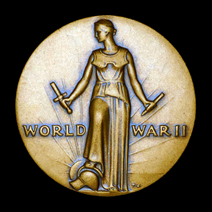 |
Return to Table of Contents
 |
416th Bombardment Group (L) The Flight Home Ferrying A-26 Aircraft from the ETO to the USA August, 1945 |
 |
While most of the Soldiers who served in the 416th Bomb Group returned home via ships, some ferried A-26 aircraft back to the USA.
The following is an analysis of the return of 1st Lt. Gentry L. "Bud" Milhorn and other 416th Bomb Group personnel
from the ETO to the USA in August, 1945 researched and written by Bud's son Richard L. Milhorn.
Capt. James P. "Jim" Phillips' Flight Echelon
First, the recollections of pilot Capt. James P. "Jim" Phillips' military history have been memorialized in his personal book, "Pillars In The Sky" (PDF). Jim was a member of the 668th Bomb Squad. According to his book, his flight echelon was sent to Liege, Belgium prior to starting the long flight back to the States. (This is interesting because accounts of the 671st Bomb Squad state that they assembled at staging area A-74 in Cambrai, France, prior to leaving for the USA). So, it appears that different squadrons were sent to different staging areas. In fact, a review of "Special Orders No. 82, 17 July, 1945" (see below) shows that flight crews from each of the four squadrons, as well as Headquarters personnel were reassigned to "Air Assembly Area, Sta A-74 for the purpose of ferrying aircraft." This would indicate that the squadrons were actually broken-up and co-mingled during the ferrying home process. Regardless of where they started the flight home, the route was the same for every officer cited in this review.
So, what exactly was the common route back to the USA? Well, whether the echelon started out from Station A-74 in Cambrai, France, or Liege, Belgium, the first stop was at an air field in Marseille, France. Next, they had two stops in Africa: an overnight stop in Marrakech, Morocco, then on to Dakar, French West Africa. They then endured the longest single flight from Dakar, across the South Atlantic Ocean to Fortaleza, Brazil. From there they flew on to Georgetown, British Guyana. The next stop was Puerto Rico, followed by the final leg to Hunter Field, Savannah, Georgia, USA.
The only point of possible disagreement in the accounts of all those discussed in this article is how long it took to make the trip. That is, Capt. Phillips describes an elapsed time of at least 10-11 days for his 668th Bomb Squad echelon; whereas, all accounts and records for Lt. Milhorn's echelon to be only 7 days in transit, to wit:
According to Capt. Phillips' book, his echelon arrived in the staging area at Liege, Belgium on July 16, 1945. Then, "On or about August 1st , we took off on our journey home". He goes on to describe each stop along the way as if only one night was spent at each location. However, he does provide a few critical dates and where his flight happened to be on those dates. The first date he recorded was that, "I think that we heard about the first atomic bomb being used against Hiroshima while we were at Fortaleza". That date would have been August 6, 1945. The next (and only other date described by Capt. Phillips) occurred as they were approaching the USA on the final leg of the journey, "When we were about three hours out of Savannah, we heard a radio broadcast that the Japanese were giving up. I don't think that day was actually V-J Day – that was celebrated a few days later".
Now, there were three important dates leading up to the surrender of the Japanese. On August 10, 1945 Japan sued for peace. On August 11, the Allies accepted the surrender and at 2400 hours on August 14, Japan surrendered. This final date is considered V-J Day, and hostilities ended. (Note: The official signing of the peace agreement did not occur until September 2, 1945)
So, based on Capt. Phillips reporting it appears to be possible that his echelon left Liege, Belgium on (or about) August 1, was in Fortaleza, Brazil on August 6, and arrived in Savannah, Georgia on perhaps August 10, or 11. Thus, according to his memoir, his trip home lasted up to 10, or 11 days.
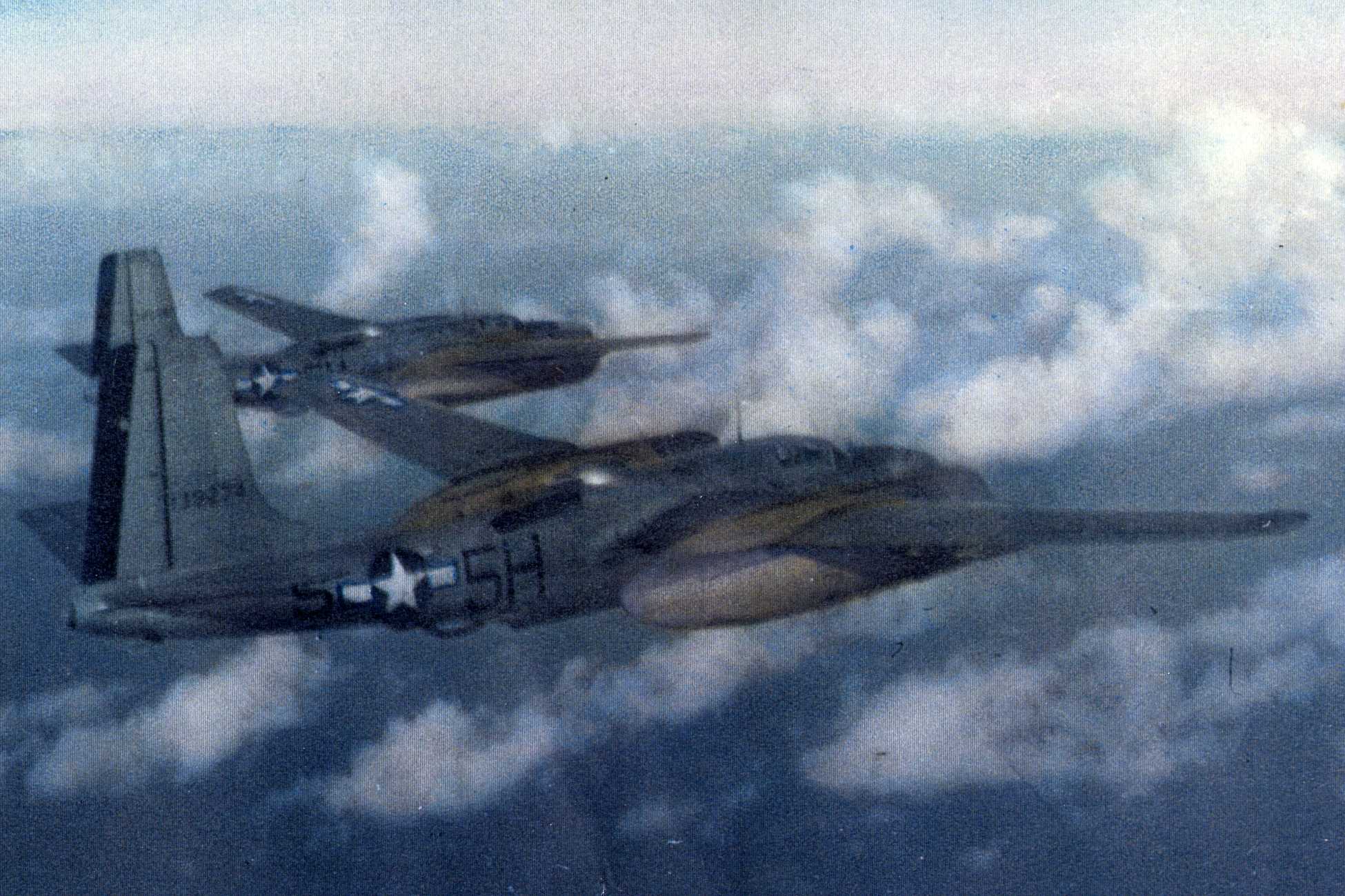
"Sugar Baby", Serial# 41-39274, 5H-S, over the South Atlantic, returning to the USA
This photo is used on the cover page of Jim's "Pillars In The Sky" (PDF) Memoirs.
Per her Individual Aircraft Record Card (IARC), 41-39274 Returned to the USA
at Hunter AAF, Savannah, GA on 18-Aug-1945.
(James P. Phillips photo collection)
1st Lt. Gentry L. "Bud" Milhorn's Flight Echelon
Now, a look at what is known of 1st Lt. Milhorn's participation in ferrying an A-26 aircraft back to the United States.
Many Return to USA via Ship
In trying to retrace the movement of some of the pilots and crews as they returned home from the ETO to the USA, a number of official orders have been reviewed and analyzed, as well as Bombardment Group and Bomb Squadron histories. Unfortunately, not every order can be found; therefore, much is open to speculation. And, not every squadron maintained the same level of recordkeeping. Thanks to the detailed personal diary of Gordon Russell and the careful organization and assembly of the contents by Jim Kerns, the "671st Bomb Squadron History" provides a glimpse into the final weeks and days that some of the combat crews spent on French soil after Germany surrendered in May,1945.
Several of the men listed in the "671st Bomb Squadron History" cited above appear in Special Orders Number 80 (15 July 1945). The officers from the 671st Bomb Squad are Lts. John Spires, Russell Simpson, Laurence Dantzer, Donald Price, and Alexander Hlivko. One other pilot for whom actual orders are available is Lt. Lumir Prucha of the 668th Bomb Squad. He, too, is listed on Special Orders Number 80 which directs flight crews from all four squadrons to report to Station A-74 "for the purpose of ferrying aircraft".
On 17 July 1945, Special Orders Number 82 assigned a number of flight crews to report to Air Assembly Area, Station A-74 on or about 20 July 1945 as "part of the main air echelon". Notable pilots among this group were headquarters personnel; Colonel Theodore R. Aylesworth, 416th Bombardment Group Commanding Officer, and Major Leland C. Nielsen, 671st Operations Officer. Also, from the 671st squadron were1st. Lt. Gentry L. Milhorn , 2nd Lt. Joseph W. Comeaux, and F/O Robert L. Acrey and their assigned crew members.
Finally, on 28 August 1945, Special Orders Number 105 was issued. A large group of 416th Bombardment Group personnel were assigned to a "Casual Pool ... for return to Zone of Interior". Among these men were Lt. Lumir J. Prucha of the 668th Bomb Squad, and Lts. John W. Spires, and Alexander E. Hlivko of the 671st. These three pilots (and many others) were probably just days away from ferrying an A-26 aircraft home when the war suddenly ended on August 14, 1945.
Lou returned to the USA via the ship S.S. Fayetteville Victory between September 8-18, 1945, disembarking at New York, then transferred to Camp Patrick Henry, Virginia. He next took a train to Ft. Leavenworth, Kansas where, on September 23, 1945, he was approved for a 45 day Temporary Duty (TDY) for travel to the Army Air Force Redistribution Station #4 at Santa Ana, California, where he reported on November 10, 1945.
Sources
The above analysis of the flight of 1st Lt. Gentry L. Milhorn, Capts Jim Phillips, Jack Buskirk and Claude Brown (and many other airmen) from the ETO to the USA in August, 1945 has been assembled from the following resources:
After two months of training for redeployment to the Pacific Theatre where the war with Japan was still raging, and after Lt. Milhorn had qualified for redeployment, he and 14 other 671st Bomb Squad pilots, their Bombardier/Navigators and crew chiefs left Station A-59 in Cormeilles-en-Vexin, France, for staging Area A-74 in Cambrai, France. This occurred between July 19 and 21, 1945. As stated on page 256 of the "671st Bomb Squadron History" (PDF) by Gordon Russell via Jim Kerns, "The personnel who left on the flight echelon are scheduled to rejoin the Squadron at the new operational base, probably in the CBI" (China-Burma-India Theatre).
The remainder of this reconstruction of the flight home is pulled from several sources that will be identified as they unfold:
First, family members of Lt. Milhorn do have anecdotal evidence of his trip. His son, Richard, remembers him saying that he was over the Atlantic Ocean when Japan surrendered. His son-in-law, Bob, remembers him telling of landing in Africa, South America, and Puerto Rico while enroute. No further details are available from Lt. Milhorn's family members.
In an email conversation (July 2, 2019) between Richard Milhorn and Craig Buskirk, son of Capt. Jack Buskirk who was one of the pilots on the flight, Craig stated that, " I know their bomb group was on their way to the Pacific and they were in Brazil when V-J Day occurred."
Further anecdotal evidence is found in the Memories section on the www.ww2buddies.com website. Here, Capt. Claude Brown who piloted an A-26 home with his longtime Bombardier/Navigator Lt. Jim Kerns on board with him had this to say, "Jim & I flew our airplane home via the southern Atlantic route. A fuel tank was installed in the bomb bay, which made it possible to fly the Invader from Dakar, West Africa to Fortaleza, Brazil. This was a flight of one aircraft, 1,900 miles over the South Atlantic Ocean. At the halfway point we contacted a Navy picket ship and learned that V-J Day had been declared".
All of the above stories play nicely into the following official documentation from both Lt. Milhorn's records and those of Capt. Buskirk:
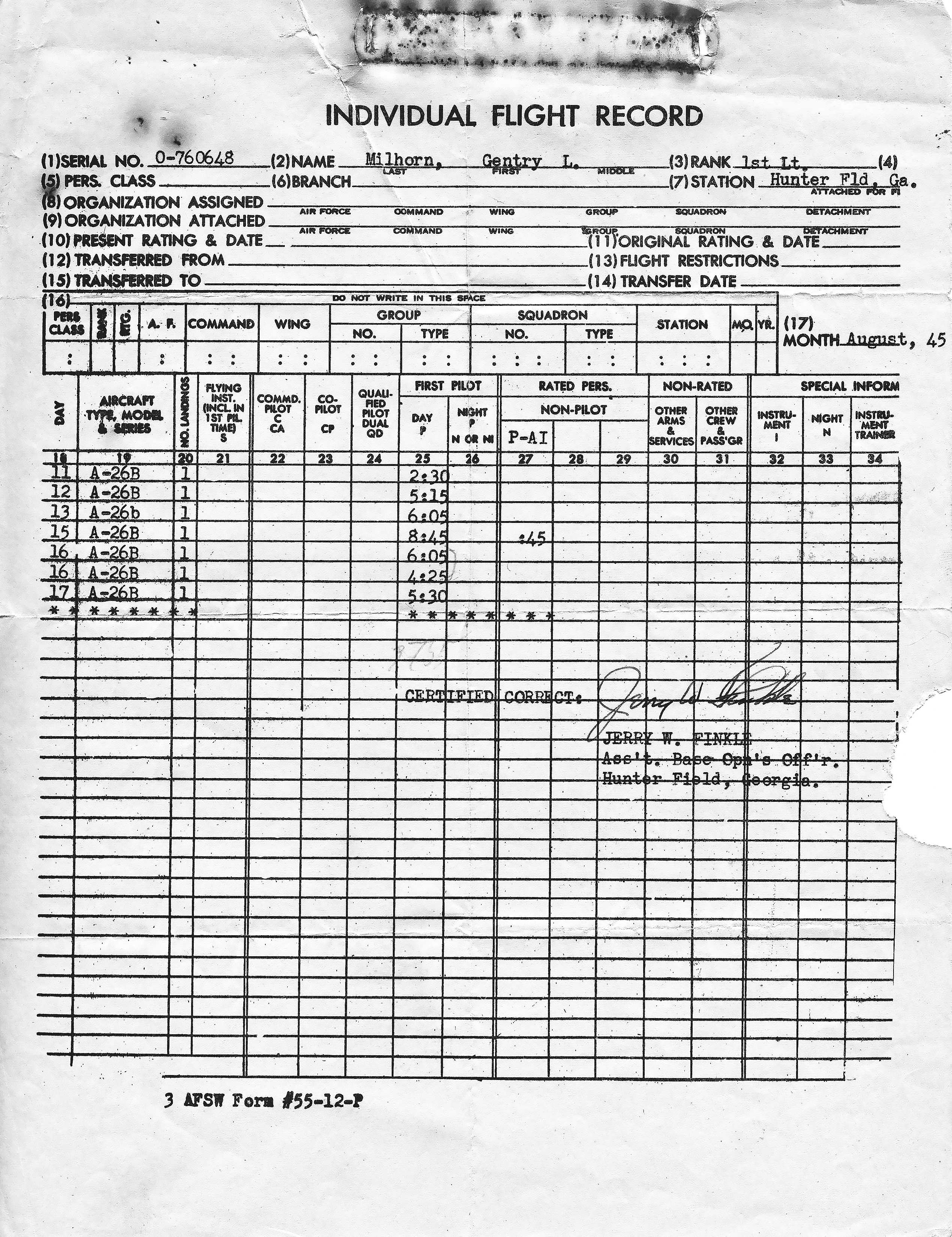
(Gentry L. Milhorn photo collection)
Lt. Milhorn's Individual Flight Record (IFR) for August, 1945 is above. Based on the dates, and hours flown, and knowing the itinerary for the return trip to the USA it can be interpreted that Lt. Milhorn flew from A-74 to Marseille on August 11, Marseille to Marrakech on August 12, Marrakech to Dakar on August 13, did not fly on August 14, then, flew from Dakar to Fortaleza on August 15, Fortaleza to Georgetown on August 16, Georgetown to Puerto Rico also on August 16, and finally to Savannah, Georgia on August 17, 1945.
Per Individual Aircraft Record Cards (IARC), the following four A-26 aircraft Returned to the USA at Hunter AAF, Savannah, GA on 17-Aug-1945: 41-39239, 41-39297, 41-39310 and 43-22499.
Departure Air Base Arrival Air Base Date Flight Time
(Hr:Min)Approximate
Distance (Miles)A-74, Cambrai, France Marseille, France 11-Aug-1945 2:30 411 Marseille, France Marrakech, Morocco 12-Aug-1945 5:15 1090 Marrakech, Morocco Dakar, French West Africa 13-Aug-1945 6:05 1310 14-Aug-1945 Did not fly Dakar, French West Africa Fortaleza, Brazil 15-Aug-1945 8:45 1930 Fortaleza, Brazil Georgetown, British Guyana 16-Aug-1945 6:06 1540 Georgetown, British Guyana Puerto Rico 16-Aug-1945 4:25 900 Puerto Rico Savannah, Georgia, USA 17-Aug-1945 5:30 1300 Totals: 7 days 38:36 8481
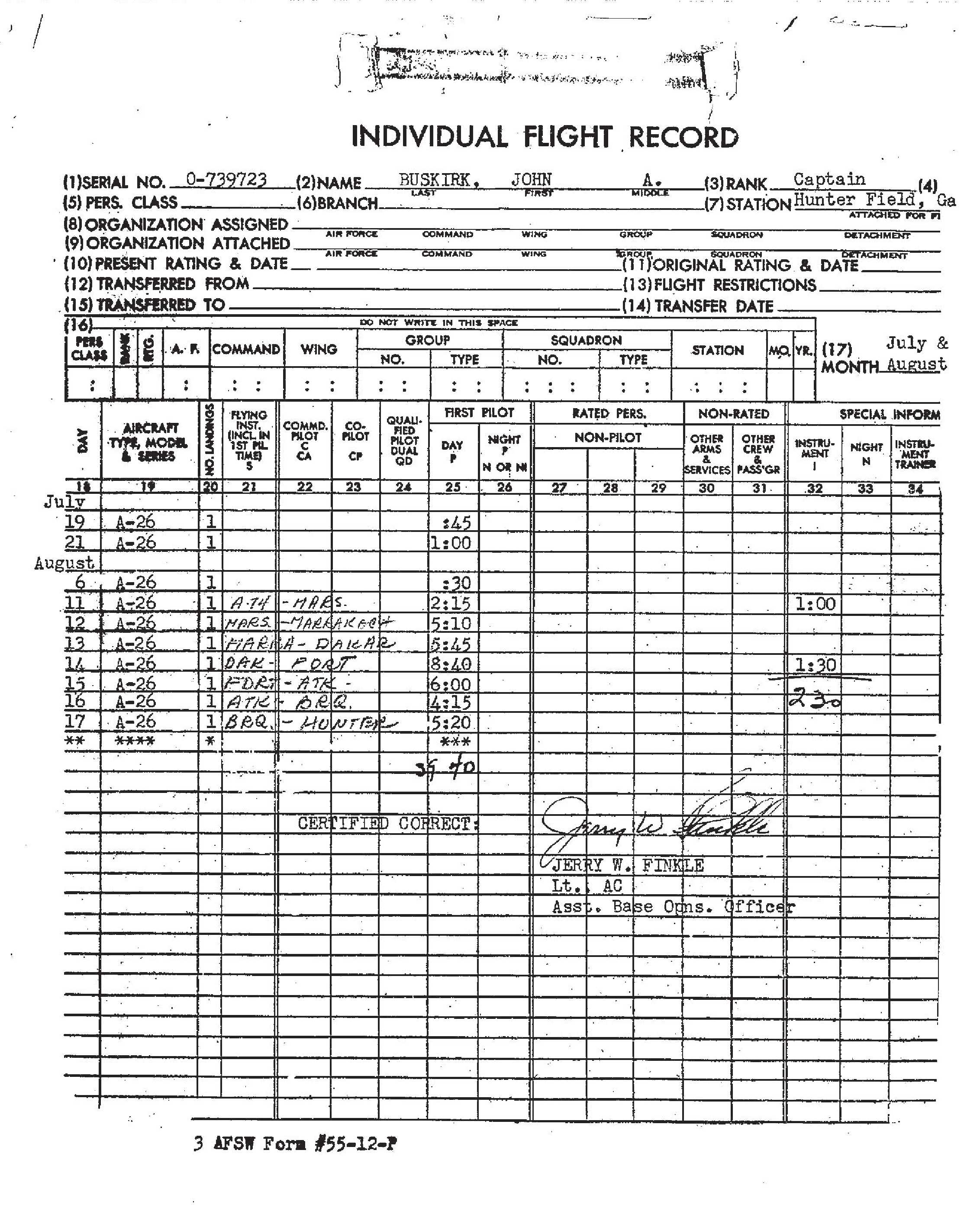
July and August, 1945 Individual Flight Record - Capt. John A. "Jack" Buskirk
(Jack Buskirk Photo Collection)
The U.S. Army Air Field near Georgetown, Guyana, during WWII was 25 miles south of Georgetown and was named Atkinson Field. It was named to honor a WWI aviator, Lt. Col. Bert M. Atkinson. Therefore, it can be assumed that the ATK on Capt. Buskirk's IFR is derived from the first three letters of Atkinson. That airport is now called Cheddi Jagan International Airport.
The U.S. Army Air Field in Puerto Rico was located near the city of Aguadilla, on Punta Borinquen. (Borinquen is the name that the indigenous people called the island before the Spaniards arrived.) Thus, the name Borinquen Field (BRQ). In 1947 that air field was renamed Ramey Air Force Base in honor of Brig. General Howard Knox Ramey who learned to fly in 1918 during WWI. He was lost at sea in 1943 during a reconnaissance flight over the Torres Strait. This airport is now called Rafael Hernandez Airport.
Departure Air Base Arrival Air Base Date Flight Time
(Hr:Min)Approximate
Distance (Miles)A-74 [Cambrai, France] MARS. [Marseille, France] 11-Aug-1945 2:15 411 MARS. [Marseille, France] MARRAKECH [Marrakech, Morocco] 12-Aug-1945 5:10 1090 MARRAK [Marrakech, Morocco] DAKAR [Dakar, French West Africa] 13-Aug-1945 5:45 1310 DAK [Dakar, French West Africa] FORT [Fortaleza, Brazil] 14-Aug-1945 8:40 1930 FORT [Fortaleza, Brazil] ATK [Atkinson Field, Georgetown, British Guyana] 15-Aug-1945 6:00 1540 ATK [Atkinson Field, Georgetown, British Guyana] BRQ [Borinquen Field, Puerto Rico] 16-Aug-1945 4:15 900 BRQ [Borinquen Field, Puerto Rico] HUNTER [Field, Savannah, Georgia, USA] 17-Aug-1945 5:20 1300 Totals: 7 days 37:25 8481
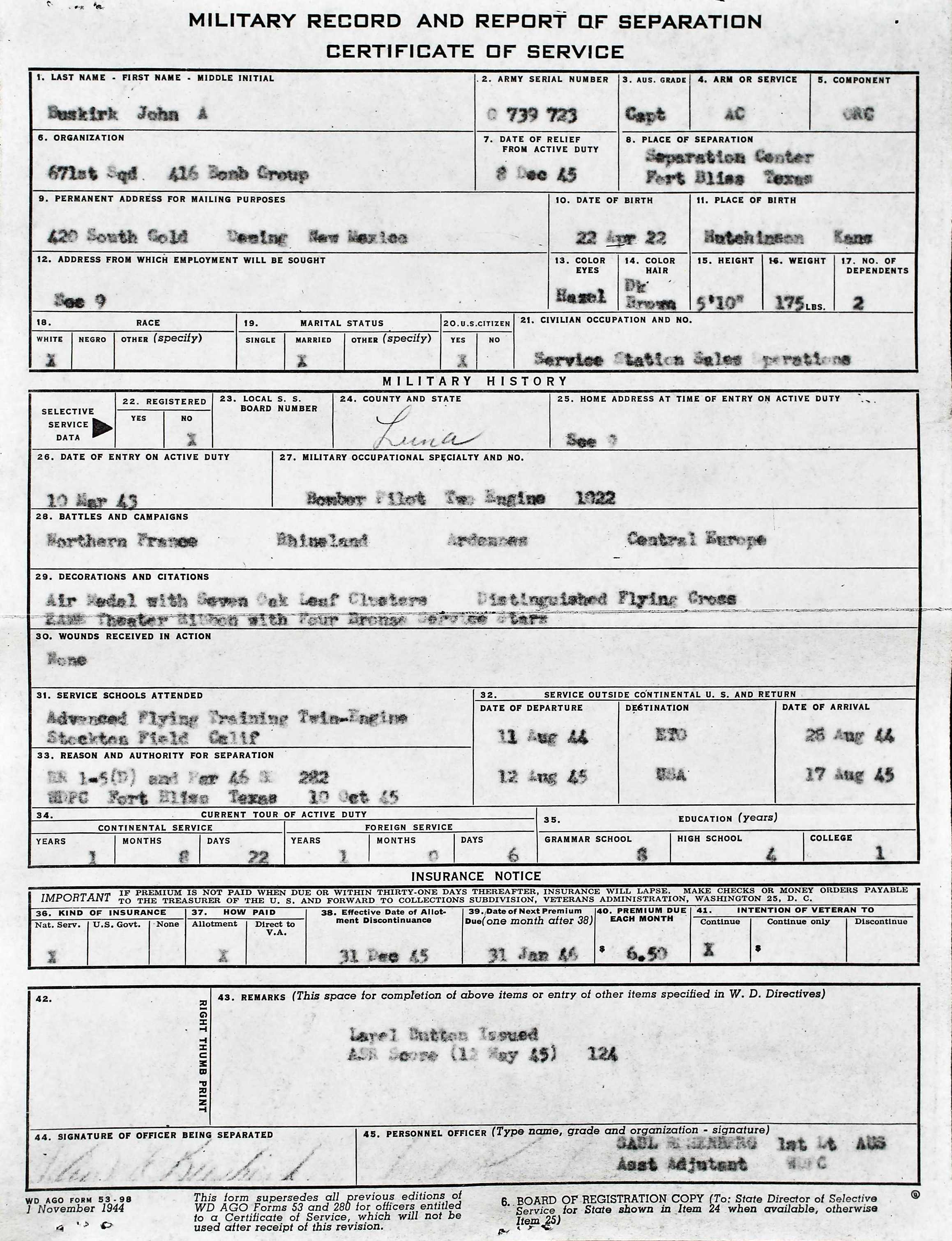
(Ancestry.com, Jack Buskirk Photo Collection)
Above, another supporting document is the Military Record And Report of Separation of Capt. Jack Buskirk. That document reports that Capt. Buskirk departed the ETO on 12Aug45 and arrived in the USA on 17Aug45. These dates coincide with Lt. Milhorn's IFR. That is based on the assumption that Capt. Buskirk's date of departure from the ETO would have been the same date that Lt. Milhorn is assumed to have flown out of Marseille (12Aug45).
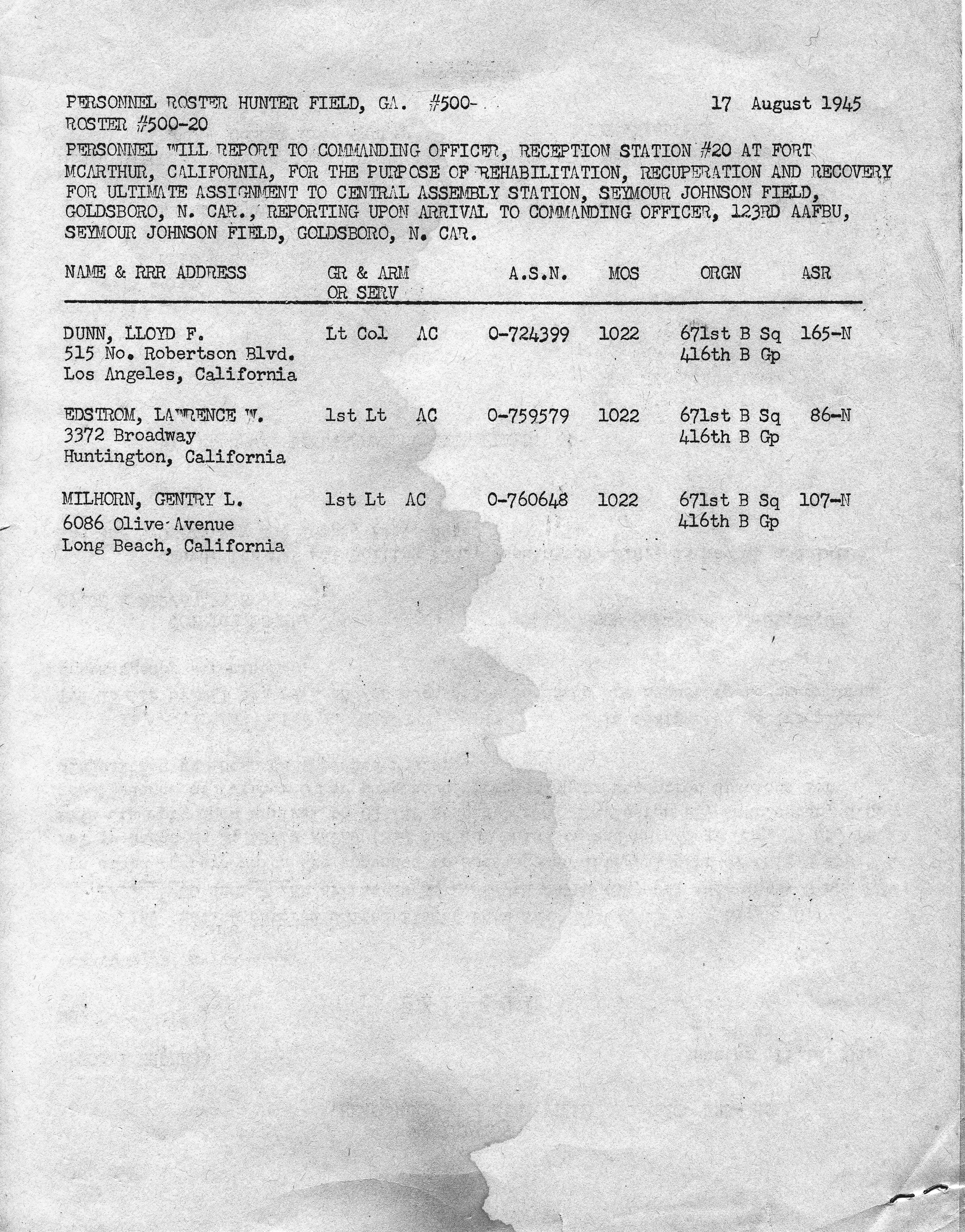
(Gentry L. Milhorn photo collection)
It appears that as soon as they landed at Hunter Field, Savannah, Georgia, reassignment orders were awaiting at least some of the returning airmen. The above PERSONNEL ROSTER HUNTER FIELD, GA. #500-20 dated 17August 1945 – the same day the men landed at Hunter Field - ordered Lt. Col. Lloyd F. Dunn, 1st Lt. Lawrence W. Edstrom, and 1st. Lt. Gentry L. Milhorn to report to "Fort McArthur, Santa Ana, California for the purpose of rehabilitation, recuperation and recovery". (Note: Santa Ana is in very close proximity to the residential addresses shown for these three men.) And, in fact, Lt. Milhorn was separated from service at the Separation Center, Fort McArthur, California on November 12, 1945, just 29 miles from his hometown of Long Beach, CA.
Although the movements of only a few of the pilots and crews can be documented, it is assumed that the following scenario played out for many other soldiers who returned to the USA:
As soon as the war ended in Europe, the airmen spent several weeks in training for redeployment to the Pacific Theater where the war with Japan was ongoing. (See "671st Bomb Squadron History", pages 253-256). Even so, some of the men who had flown their quota of missions were rotated back to the USA. They were replaced with officers and enlisted men, some of which had fought in other Bomb Groups, and some with no combat experience at all. In the months of May and early June the following officers were assigned to the 671st Squadron: Capt. Olson (had flown 75 missions with other Bomb Groups), and Lts. Mallery, Dantzer, Comeaux, and F/O Acrey (all four of which had no 416th Bomb Group combat experience that has yet been verified).
As the month of July proceeded, the men began to hear rumors of redeployment, and about the middle of the month they started getting orders to move. Finally, on July 16 & 17, five 671st pilots with engineer gunners flew excess aircraft to Assembly Area, Station A-74. These pilots were: Lts. Hlivko, Dantzer, Spires, Price, and Simpson. Lt. Graeber had preceded them by a few days.
Now, the 671st had 15 remaining pilots who were to be in the actual air echelon that would ferry the aircraft back to the USA. Ten of the pilots left Station A-59 for Assembly Area, Station A-74 on July 19, including: Lt. Col. Dunn, Capts. Brown, Buskirk, Olson, Tutt, and Lts. Cooke, Edstrom, Mallery, Mooney and Wright. Also included in the flight echelon were five Bombardier/Navigators, Lts. Brewer, Kerns, Corum, Reed and F/OBrandt. (Note: Many of the officers and enlisted men that did not get assigned to a flight echelon would ultimately be returned home via ship.)
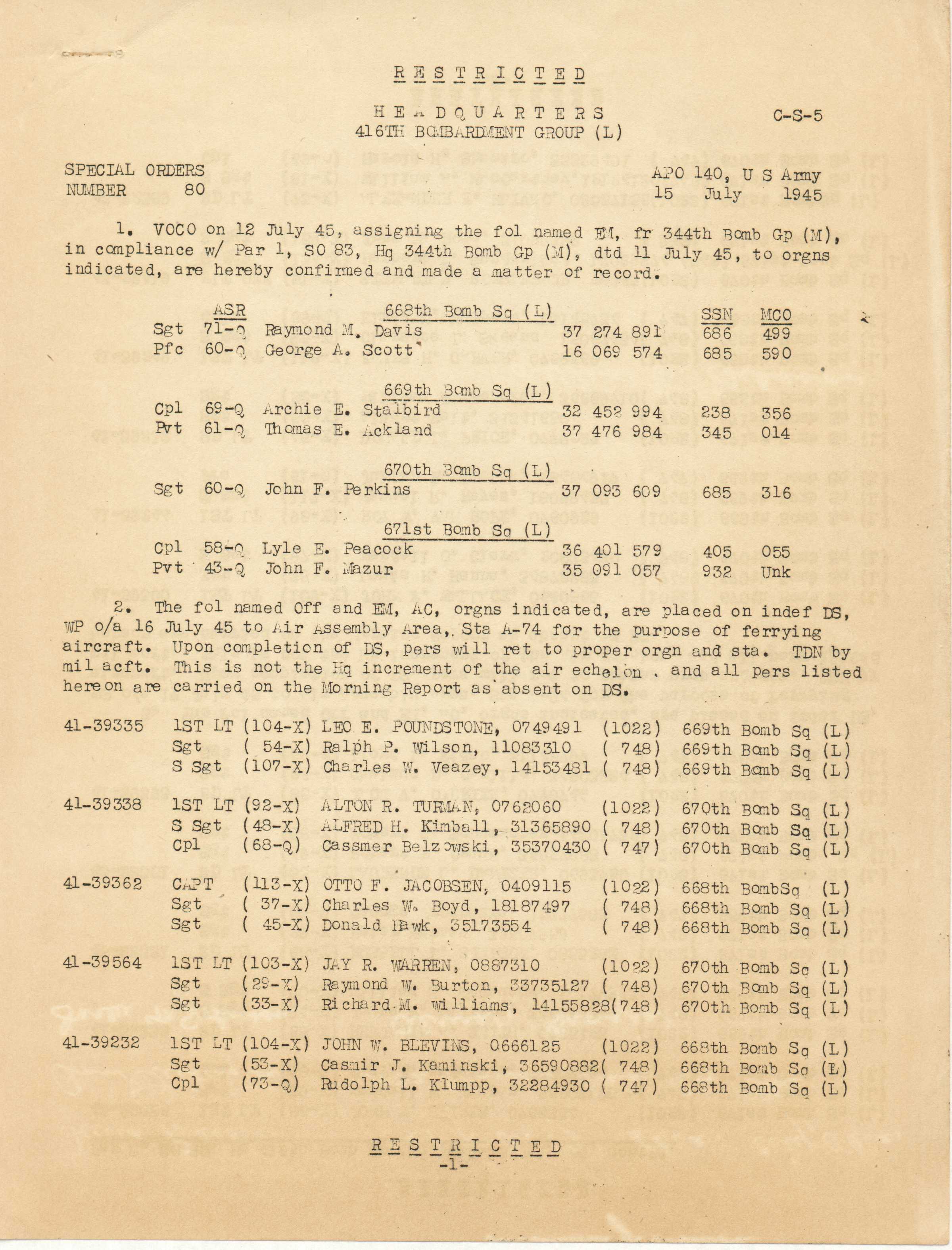
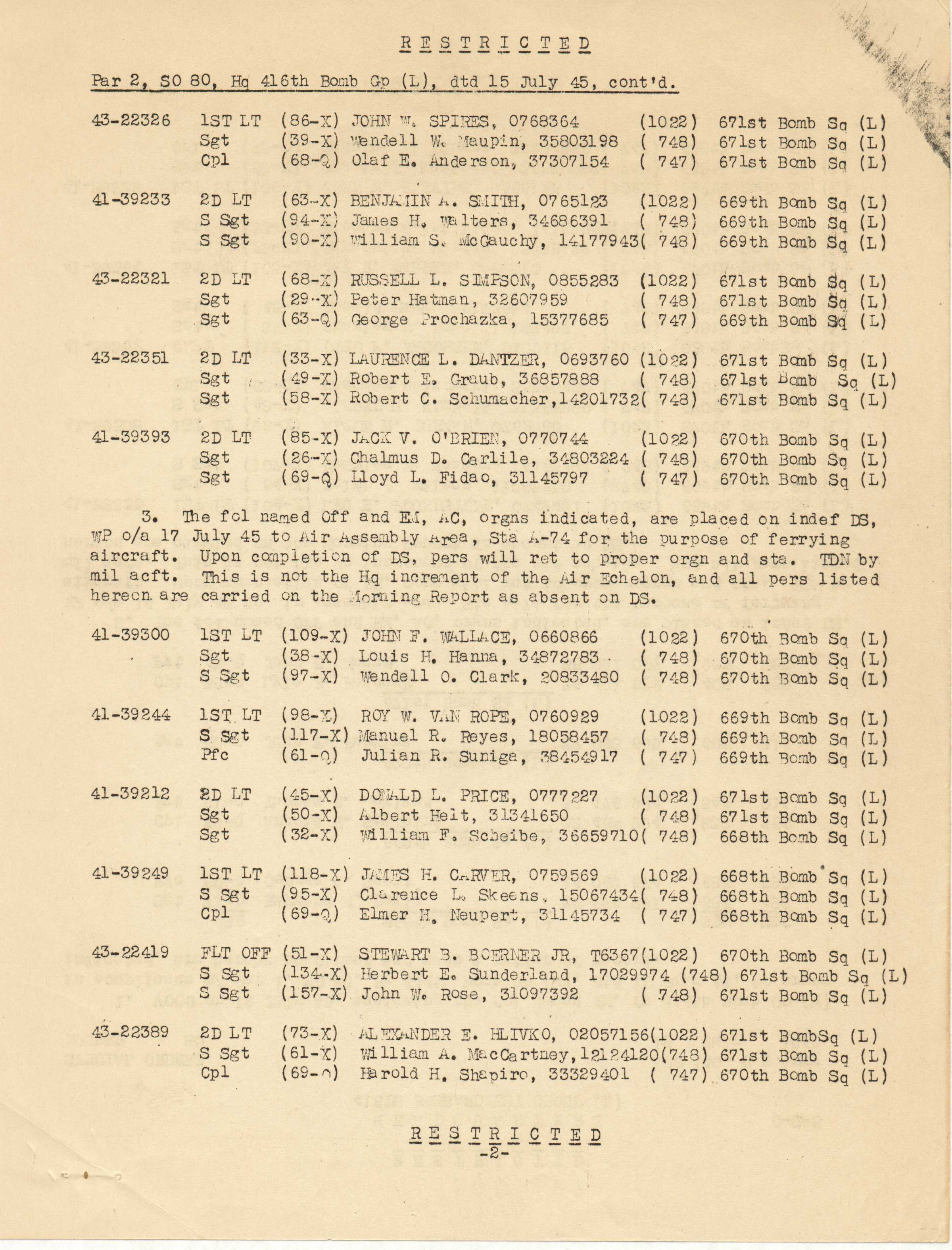
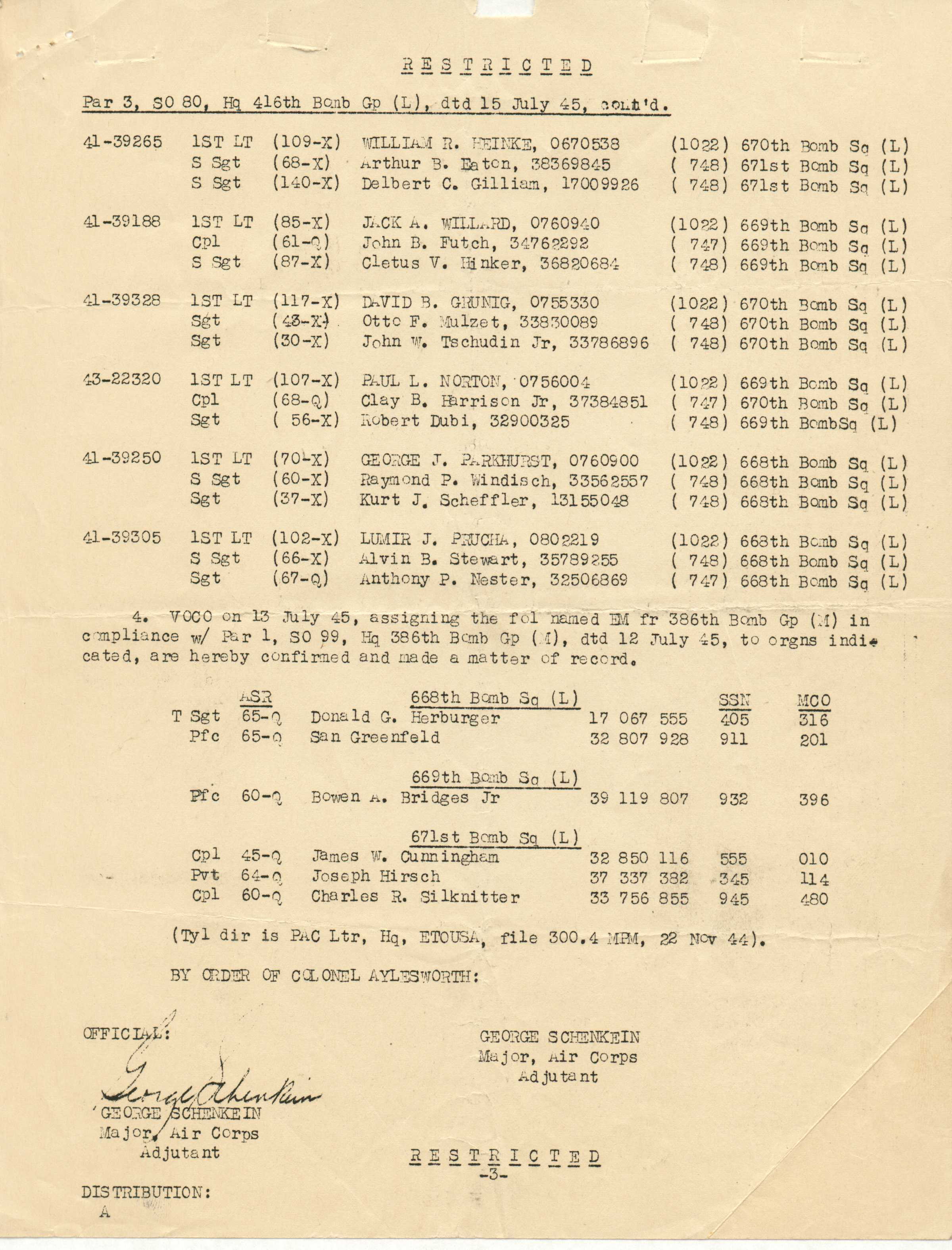
Special Orders No. 80, 15 July, 1945
(Lou Prucha WWII Service)
Upon correlation to Individual Aircraft Record Cards (IARC) for the Aircraft Serial Numbers listed in these orders, it appears that the following 13 A/C were NOT returned to the USA and were Condemned/Salvaged overseas: 41-39188, 41-39212, 41-39244, 41-39249, 41-39250, 41-39265, 41-39300, 41-39305, 41-39328, 43-22321, 43-22326, 43-22389 and 43-22419.


Special Orders No. 82, 17 July, 1945
(Garland D. Murphy Jr. photo collection)
As has been documented, according to Lt. Milhorn’s and Capt. Buskirk’s IFRs, their echelon departed from Station A-74 on August 11, and left the ETO from Marseille on August 12, 1945. While their echelon was enroute to the USA, Japan surrendered and World War II came to an abrupt end.
It would appear that the urgent need to ferry aircraft back to the USA was thereby abated and that many pilots and flight crews were redirected home via ship, rather than by air. This was quite disappointing to those flight crews that had been standing-by to fly home. Also disappointing was that many of these airmen were somewhat stranded in France for several more weeks awaiting final orders to return to the USA.
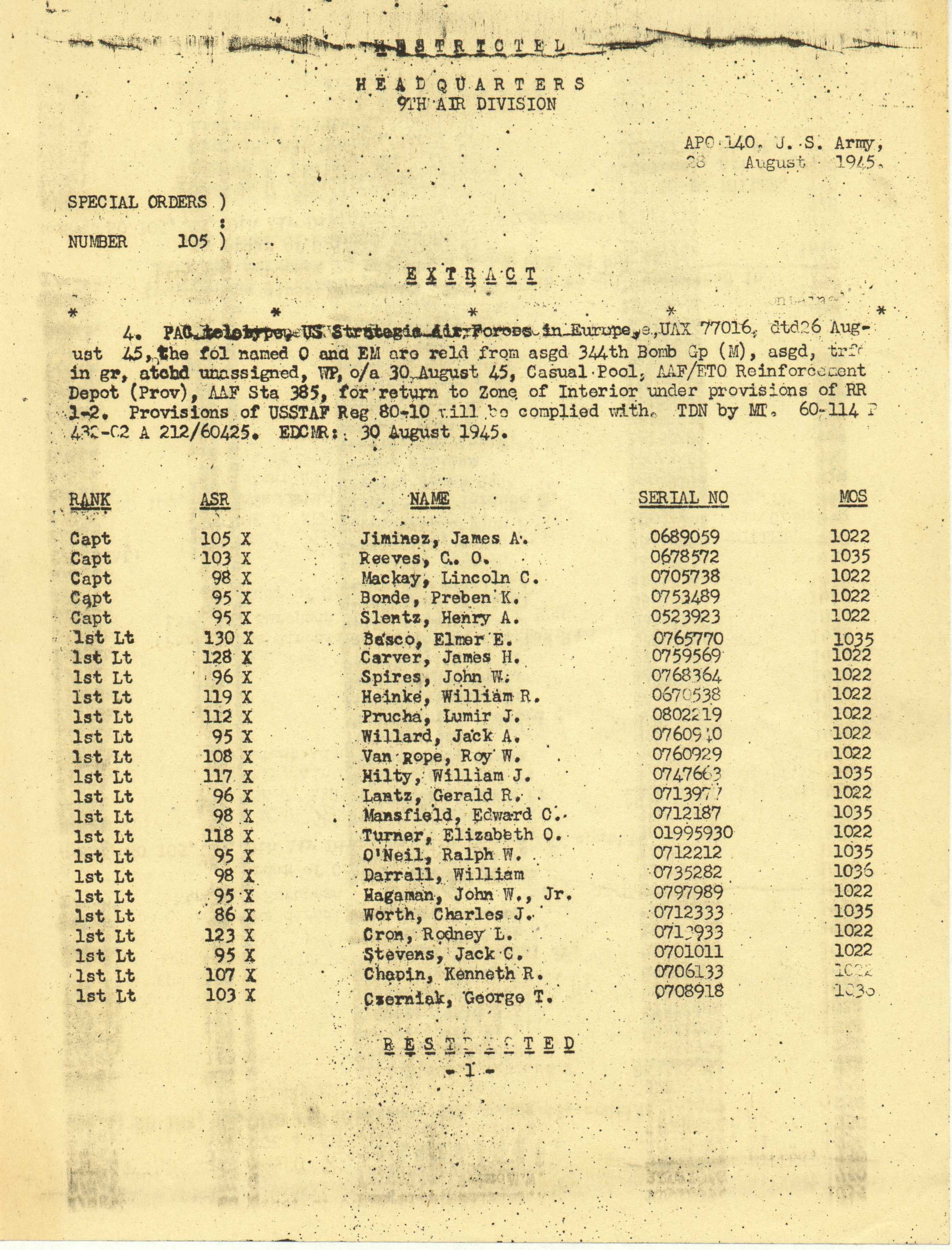
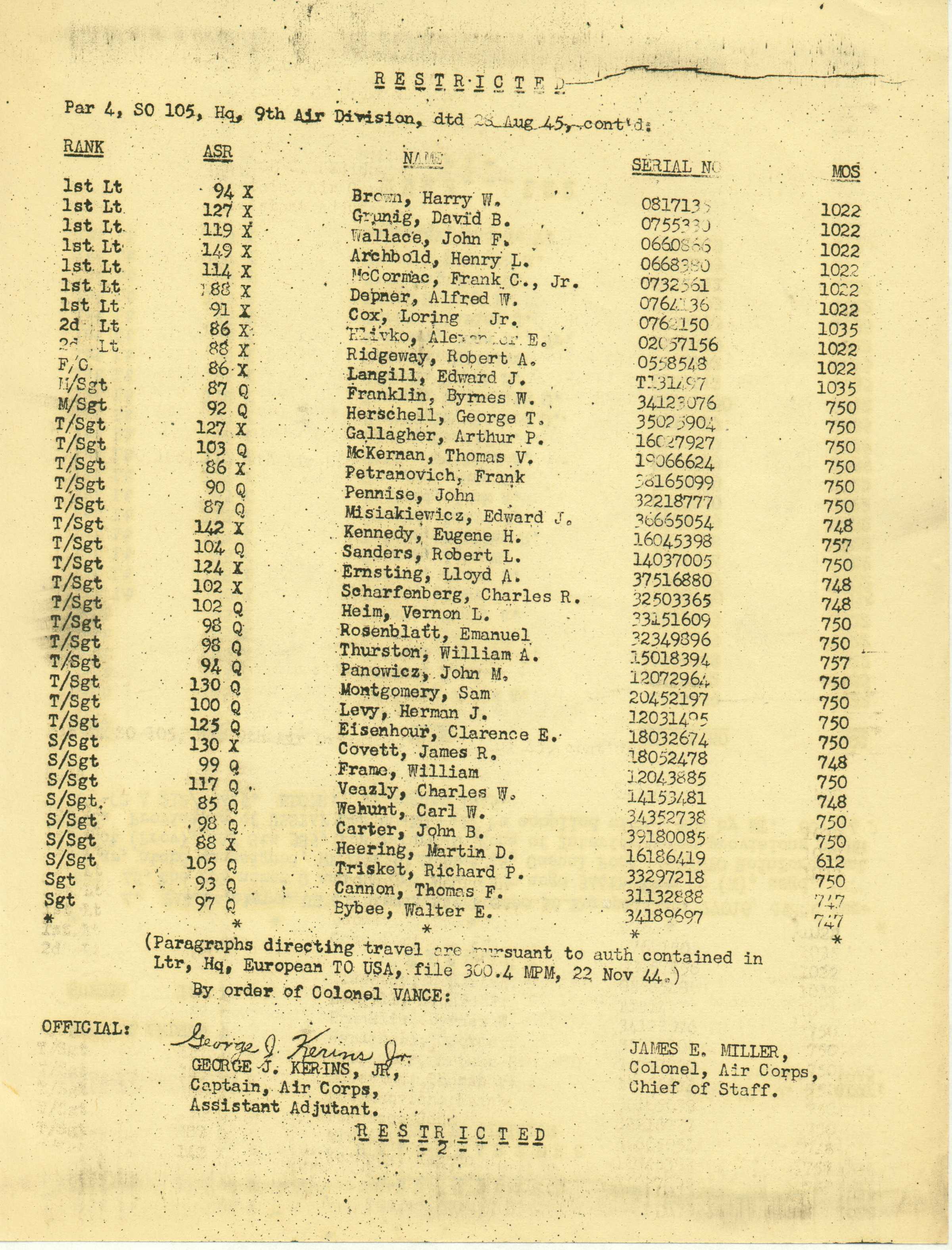
Special Orders No. 105, 28 August, 1945
(Lou Prucha WWII Service)
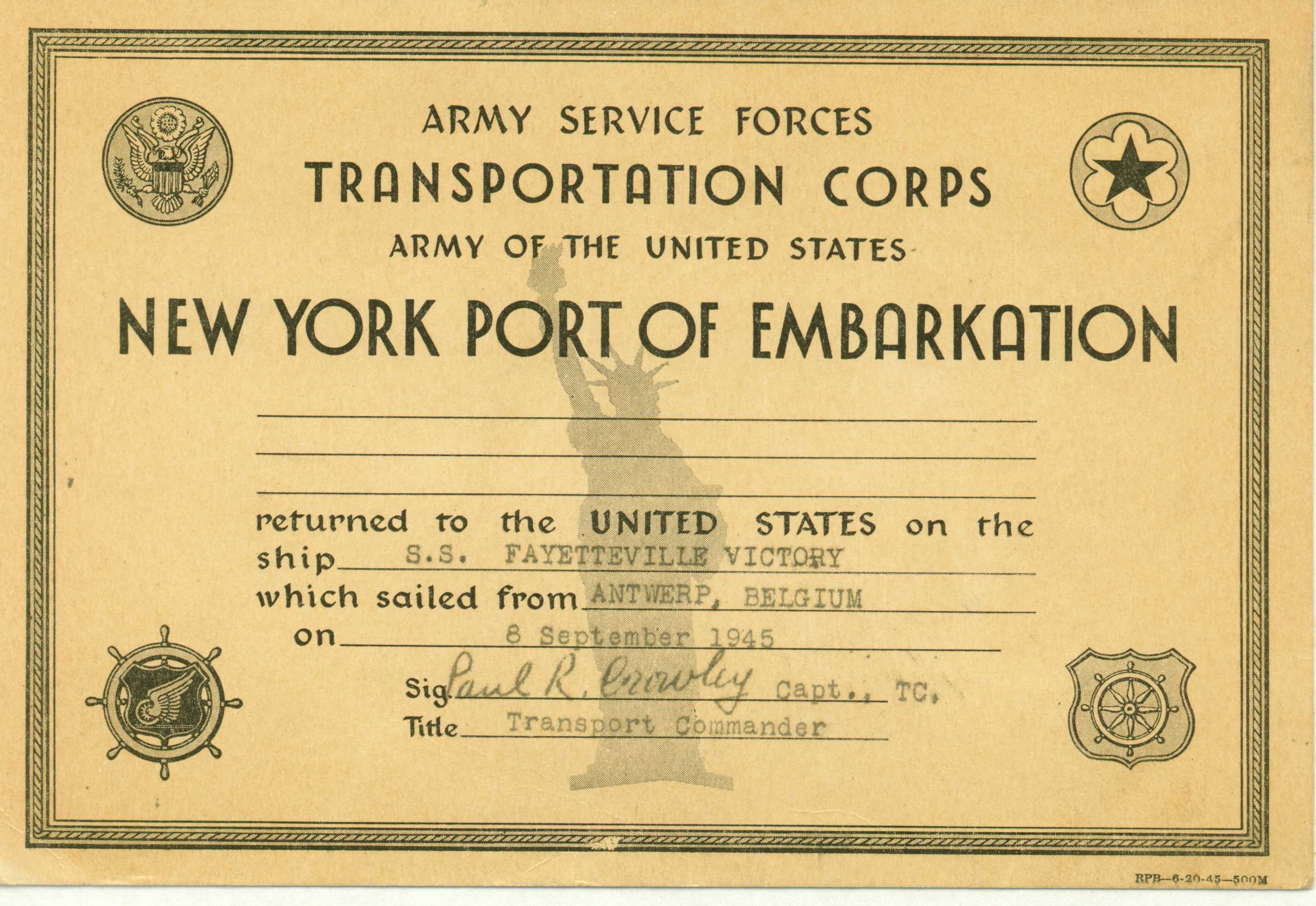
S.S. Fayetteville Victory Transport, 8 September, 1945
(Lou Prucha WWII Service)
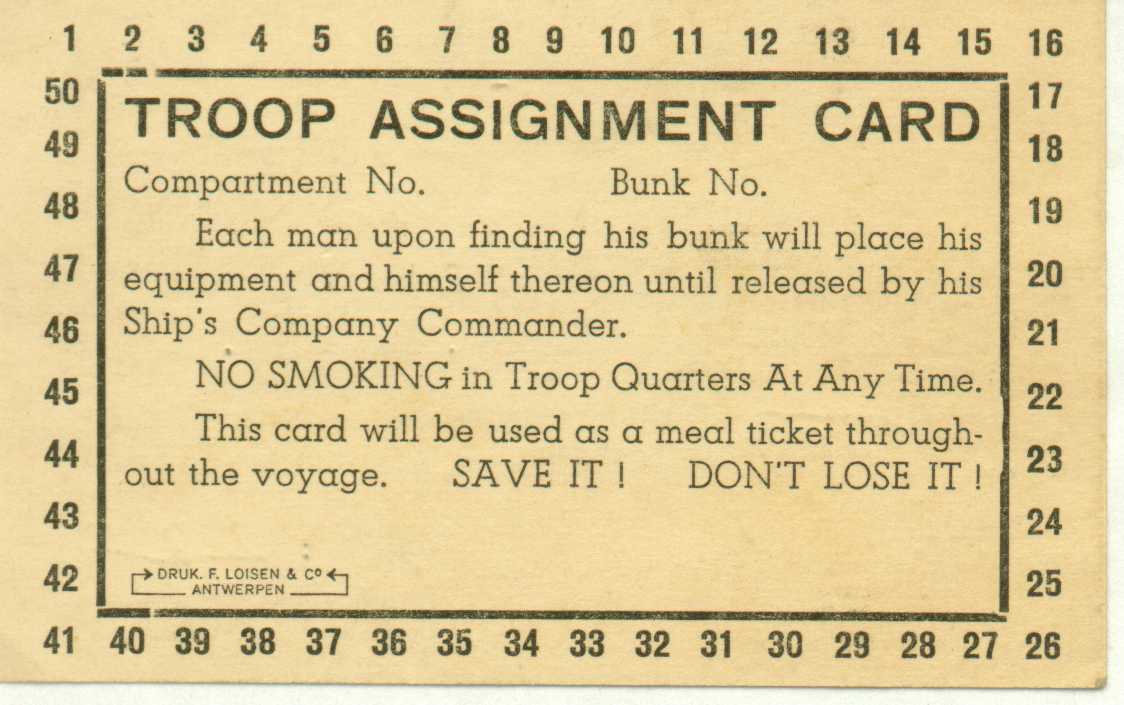
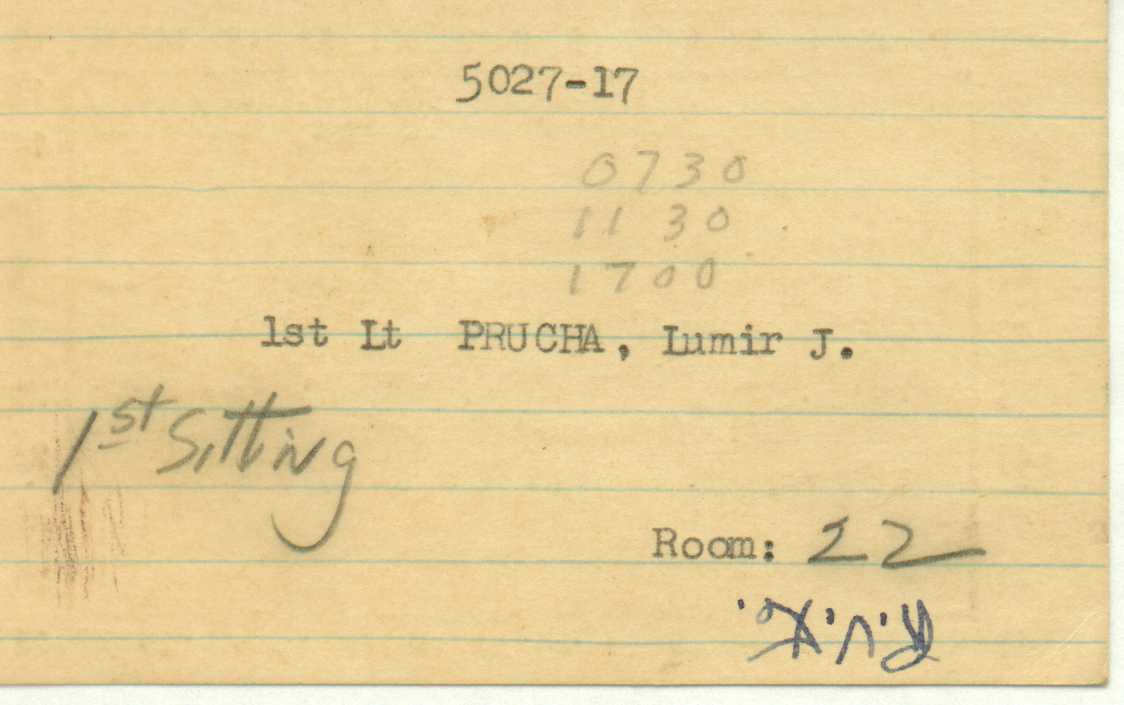
Troop Assignment Card
(Lou Prucha WWII Service)
1st Lt. Lumir J. Prucha was honorably discharged from the Army of the United States on January 14, 1946.
1) "Pillars In The Sky" (PDF) by Jim Phillips – Pages 87-91
2) "671st Unit History" (PDF) by Gordon Russell via Jim Kerns – Pages 255-256
3) Capt. Claude Brown – Memories on www.ww2buddies.com website
4) Lt. Gentry L. Milhorn – Photo Collection, Post WWII Obituary, Individual Flight Record - August, 1945
5) Lt. Gentry L. Milhorn – Anecdotes remembered by family members
6) Capt. John A. "Jack" Buskirk – Photo Collection, Individual Flight Record - July and August, 1945, Record of Separation – December 8, 1945
7) Capt. John A. "Jack" Buskirk – Anecdotes remembered by family members
8) Garland D. Murphy Jr. Photo Collection
9) Lou Prucha WWII Service
Within the documents cited above and through anecdotal evidence (stories recited by 1st Lt. Gentry Milhorn and by Capt. Jack Buskirk that have been recalled by various relatives) there are many certifiable facts. There are a few mistaken dates and possibly some faulty recollections, as well. However, after much research and verification the following synopsis is thought to be as accurate as possible considering the 75 year interval between the events and the writing of this article.
(Any corrections, additions, or suggestions regarding this document are encouraged and will be gratefully received by the author, Richard L. Milhorn - please Contact the 416th BG Archive.)